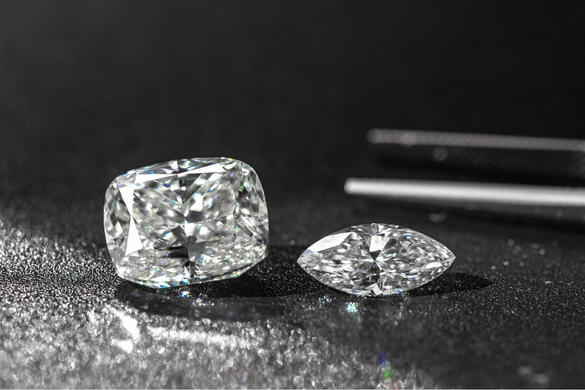Diamonds: Mined and Lab Grown–Two Sides of the Same Coin

Diamonds: Mined and Lab Grown–Two Sides of the Same Coin
For centuries, just as ardently as Alchemists have endeavoured to conjure up a formula for producing gold, scientists have attempted to make diamonds in laboratories. Industrialists everywhere were, to say the least, tipping off their hats to GE, when the company first created what is considered a true man-made diamond, back in 1970 – with actual diamond material (i.e. pure carbon, crystallized in isotropic 3D form). So, now that man-made diamonds are being manufactured for the gem and jewellery sector, why isn’t everyone in that space shouting “Eureka” too?
As with every other significant stride of science, there is a lot of insecurity shrouding this big achievement. Consumers of diamonds as well as players of the gem and jewellery industry are afraid because of the possibility of misuse of this new, amazing technology by surreptitious elements. Unfortunately, their fears are not entirely unfounded – There have already been cases reported of people in the diamond trade mixing lab-grown diamonds with mined ones, and selling them to people down the distribution chain. There may also be cases of retailers having knowingly misrepresented lab-grown diamonds as mined diamonds.
If the issue of selling lab-grown diamonds masquerading as naturally mined ones is not nipped in the bud, it could very possibly shake the very foundation of the diamond industry. So, how can the industry calm the palpable mistrust and prevent its putrid ramifications from being felt for decades to come? The answer quite clearly lies in the understanding that natural mined diamonds and lab-grown diamonds should be looked at as two sides of the same coin. The only way that the natural mined diamond and its lab-grown counterpart can each have the brilliant future it deserves, is if the lab-grown diamond is given its own rightful place as an extension of the same product category. The time to make the proper integration is NOW.
So, how should the Gem and Jewellery industry go about achieving a harmonious co-existence of natural mined diamonds and man-made diamonds? The Experts at GemAtlas have some valuable suggestions:
Don’t risk long-term credibility for short-term gains: The imminent widespread availability of testing facilities makes it foolish for anyone to want to risk reputation, disintegration of trust among an existing customer-base, a deluge of returned products in the future and likely legal action, by indulging in fraudulent sale of lab-grown diamonds as natural mined diamonds. Since the law does not excuse “ignorance”, it is the onus of companies selling diamonds to have them tested for authenticity. Industry bodies in most countries already have a list of “blacklisted” diamond merchants! They have formed committees to monitor incidents involving mixing of lab-grown, man-made diamonds with natural mined diamonds. They have been commissioning investigations to help address the issue at all levels, and punish errant merchandisers.
Call a lab-grown diamond a “lab-grown diamond”: The law states that man-made diamonds have to be called only either “man-made diamonds” or “lab-grown diamonds”. Either of these terms must be used in all marketing communications, and has to be communicated to the customer before purchase as well. Lab-grown diamonds cannot be called “diamonds” only.
The law aside, all dealers including small independent jewellers and retailers selling diamonds without certificates, must take it upon themselves to adhere to strict “self declaration” practices. There should be complete self-monitored honesty.
Look at lab-grown diamonds as an opportunity to operate in another market segment: Market research studies show that the target market segments for man-made diamonds and lab-grown ones are completely separate. Perhaps the best parallel that can be drawn here is that of the history written by the cultured pearl, which was first marketed by Mikimoto way back in 1916. The early manufacturing of the cultured pearl brought with it many insecurities about the fate of the natural pearl, but all that quickly settled with knowledge about them being distinguishable from each other, and each enjoyed its own unique place in the jewellery space.
Much like the pearl, the future of the diamond market lies in understanding the different target market segments – Besides the obvious offering of a cheaper alternative that will increase the consumer-base of diamonds, innumerable studies show that the main takers of lab-grown diamonds will be people who want “blood-free” stones. The marketing communications of companies retailing man-made diamonds seem to corroborate this with their value propositions – They tend to lean towards psychographic segments that are attune to environmental concerns, as well as people with trepidation about mining and manufacturing labour practices in the case of mined diamonds. Those fascinated by the “exclusivity” of mined diamonds are likely to demonstrate continued loyalty towards them. People looking for investment capital appreciation are also likely to remain loyal to mined diamonds.
Industry players would do well to understand that these clearly defined market segments present an opportunity to expand reach by embracing the honest marketing of man-made diamonds.
Educate consumers about man-made diamonds and the availability of testing facilities: The Gem and Jewellery industry has initiated steps to allow anyone to be able to avail of facilities to have their diamonds tested. Many countries already have facilities where people can walk in and avail of testing services. Retailers should take it upon themselves to make consumers aware of the different product categories. Consumers should be given the right to choose between the two, and even categories within each, factoring price and other considerations into their purchase decision.
Sell both natural mined diamonds and lab-grown diamonds with certificates: It is expected that sooner or later, the law will make it mandatory to sell lab-grown diamonds with certificates stating that they are man-made diamonds. As is done with mined diamonds, certification will likely involve a serial number laser engraved on the stone and matched with that of a paper-certification to corroborate authenticity. If diamond retailers make a commitment to start selling certified lab-grown and well as certified mined diamonds, right away, there will be no trust issues among buyers, and the industry will be able to prevent a lot of malpractice right here and now.
Keep supply chains separate: What’s important at this nascent stage of its product lifecycle is that lab-grown diamonds be properly integrated into the diamond jewellery business with the right kind of checks and controls to keep the supply chains separate. This will minimise the chances of “mixing” and help both segments shine in the future.
All of us who form part of the diamond, gem and jewellery industry have a moral responsibility towards our buyers and towards the survival of the diamond industry. The consumer needs to believe in the goodwill of the industry now more than ever before – If we let our consumers down today, and swap honesty and integrity for the momentary extra profits we might be able to earn till testing equipment is more easily accessible, we will be causing permanent damage not only to the future of our individual businesses, but to the industry as a whole.
Whether it is the karatage of gold, the quality of stones, or what type of diamonds we are selling, the responsibility of honestly defining each product we sell rests squarely with each one of us.

